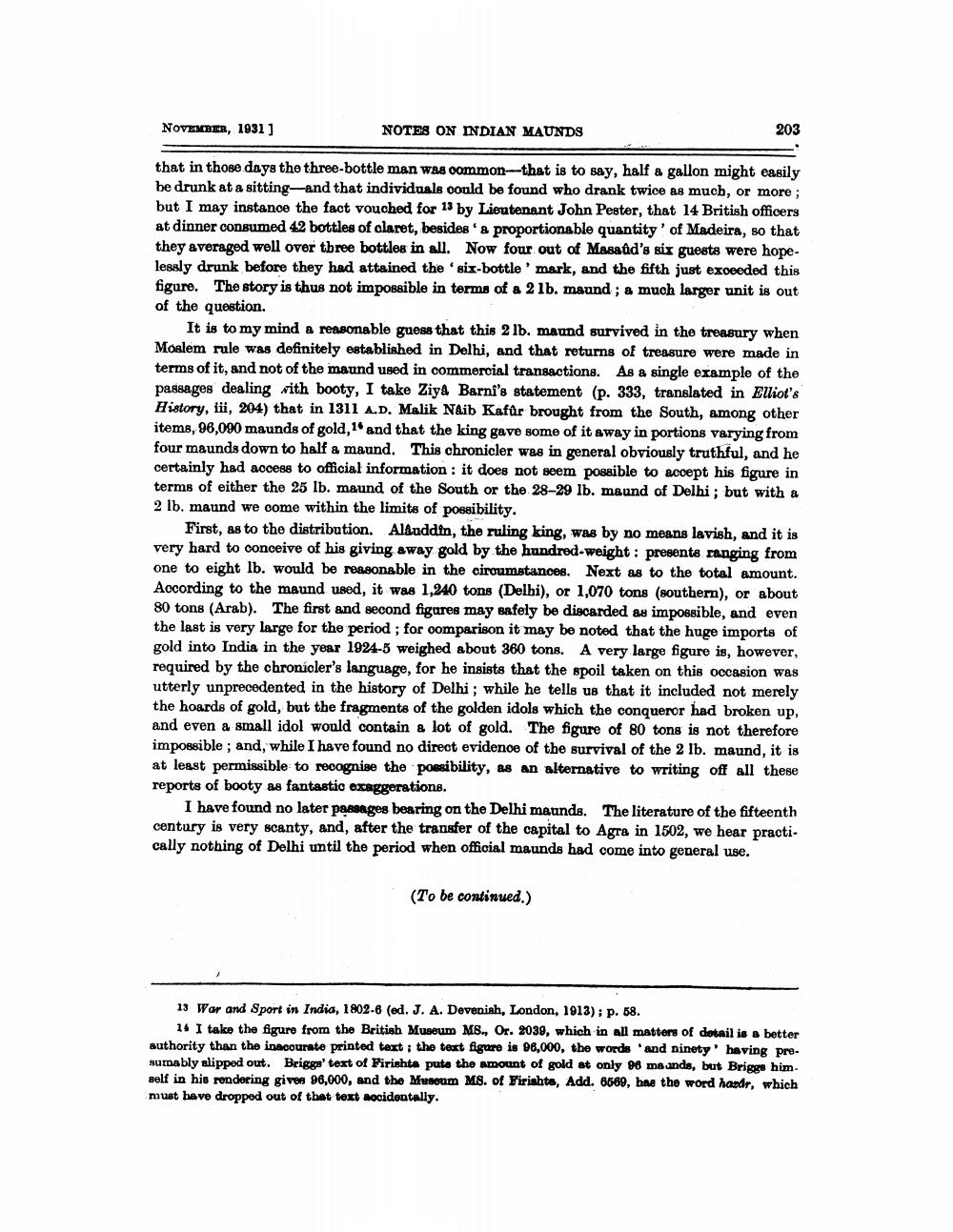________________
NOVEMBER, 1931)
NOTES ON INDIAN MAUNDS
203
that in those days the three-bottle man was common---that is to say, half a gallon might easily be drunk at a sitting-and that individuals conld be found who drank twice as much, or more ; but I may instance the fact vouched for 13 by Lieutenant John Pester, that 14 British officers at dinner consumed 42 bottles of claret, besides & proportionable quantity of Madeira, so that they averaged well over three bottles in all. Now four out of Masalld's six guests were hopelessly drunk before they had attained the six-bottle 'mark, and the fifth just exoeeded this figure. The story is thus not impossible in terms of a 2 lb. maund; a much larger unit is out of the question.
It is to my mind a reasonable guess that this 2 lb. maund survived in the treasury when Moslem rule was definitely established in Delhi, and that returns of treasure were made in terms of it, and not of the maund used in commercial transactions. As a single example of the passages dealing with booty, I take Ziya Barni's statement (p. 333, translated in Elliot's History, iii, 204) that in 1311 A.D. Malik Naib Kafür brought from the South, among other items, 96,090 maunds of gold, 1. and that the king gave some of it away in portions varying from four maunds down to half a maund. This chronicler was in general obviously truthful, and he certainly had access to official information : it does not seem possible to accept his figure in terms of either the 25 Ib. maund of the South or the 28-29 lb. maund of Delhi; but with a 2 lb. maund we come within the limits of possibility.
First, as to the distribution. Alauddin, the ruling king, was by no means lavish, and it is very hard to conceive of his giving away gold by the hundred-weight: presents ranging from one to eight lb. would be reasonable in the circumstances. Next as to the total amount. According to the maund used, it was 1,240 tons (Delhi), or 1,070 tons (southern), or about 80 tons (Arab). The first and second figures may safely be discarded as impossible, and even the last is very large for the period; for comparison it may be noted that the huge imports of gold into India in the year 1924-8 weighed about 360 tons. A very large figure is, however, required by the chronicler's language, for he insists that the spoil taken on this occasion was utterly unprecedented in the history of Delhi; while he tells us that it included not merely the hoards of gold, but the fragments of the golden idols which the conqueror had broken up, and even a small idol would contain a lot of gold. The figure of 80 tons is not therefore impossible ; and, while I have found no direct evidence of the survival of the 2 lb. maund, it is at least permissible to recognise the possibility, as an alternative to writing off all these reports of booty as fantastic exaggerations.
I have found no later passages bearing on the Delhi maunds. The literature of the fifteenth century is very scanty, and, after the transfer of the capital to Agra in 1502, we hear practically nothing of Delhi until the period when official maunds had come into general use.
(To be continued.)
13 War and Sport in India, 1802-6 (ed. J. A. Devenish, London, 1913); p. 68.
14 I take the figure from the British Museum MB., Or. 2039, which in all matters of detail is a better authority than the inacourate printed text; the text figure is 96,000, the words and ninety' having presumably slipped out. Briggs' text of Firishta puts the amount of gold at only 98 maands, but Briggs him. self in his rendering given 96,000, and the Museum MS. of Firishta, Add. 6669, hae the word haudr, which must have dropped out of that text mocidentally.




